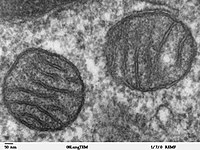
Photo from wikipedia
The opening of mitochondrial permeability transition pore (mPTP) plays a fundamental role in cell apoptosis regulation, ischemia-reperfusion injury, and neurodegenerative disorders. However, the molecular tools for detecting mPTP open in… Click to show full abstract
The opening of mitochondrial permeability transition pore (mPTP) plays a fundamental role in cell apoptosis regulation, ischemia-reperfusion injury, and neurodegenerative disorders. However, the molecular tools for detecting mPTP open in cellular native status have not been reported yet. Herein, we de novo designed a robust fluorescent probe mPTP-F to monitor mPTP opening in cellular native status for the first time. The membrane-permeable probe could accumulate into mitochondria and convert to a product poorly permeable to biomembranes, which was trapped in mitochondria to form near-infrared (NIR)-emissive aggregates. After mPTP opening, the product was released from mitochondria through the pore to form green-emissive monomers. Significantly, with mPTP-F, we discovered that formaldehyde, a signaling molecule, could induce mPTP opening. Therefore, the new probe could serve as a desirable molecular tool for the study of ischemia-reperfusion injury, cell apoptosis, and relative areas.
Journal Title: Analytical chemistry
Year Published: 2022
Link to full text (if available)
Share on Social Media: Sign Up to like & get
recommendations!